Sport bike engine specifications are so essential that they can make or break your entire riding experience. You might be wondering what really goes into these sophisticated machines that define speed and agility on the road. From engine displacement to power output and torque ratings, every component plays a significant role in performance. But what about the advanced technologies like fuel injection systems and cooling mechanisms? Understanding these details could elevate your appreciation of sport bikes to a whole new level.
Key Takeaways
- Sport bike engines often feature L-Twin designs, providing immediate torque and enhanced stability for responsive handling.
- Superquadro technology in engines allows for high RPMs with lightweight materials, boosting speed and durability.
- The Desmodromic Valve System ensures precise valve timing, improving throttle response and contributing to engine longevity.
- Liquid cooling systems maintain optimal engine temperatures, enhancing performance during intense rides.
Overview of Ducati Engines
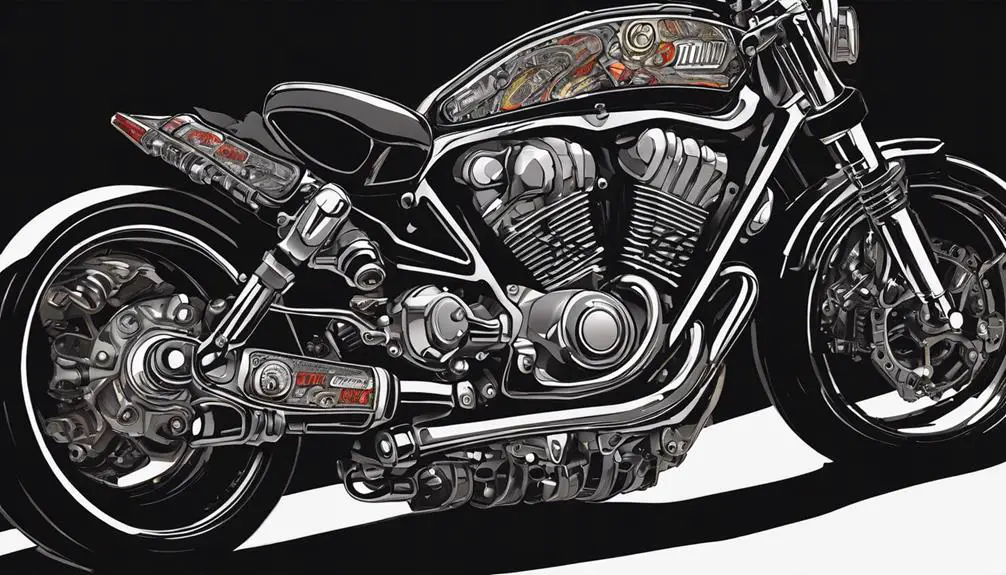
Ducati's engines are renowned for their performance, blending cutting-edge technology with Italian craftsmanship to deliver an exhilarating riding experience. When you twist the throttle, you feel the power surge beneath you, igniting a passion that fuels your desire for freedom on the open road. The meticulous engineering behind each engine guarantees that you're not just riding a motorcycle; you're embracing a lifestyle defined by speed, precision, and the pure joy of the ride.
These engines are designed to offer responsive handling and breathtaking acceleration, making every journey feel like an adventure. With lightweight construction and a commitment to performance, Ducati creates a harmonious balance between power and agility. You'll find that the roar of the engine isn't just a sound; it's a symphony that calls you to explore new horizons and chase the thrill of the next bend.
Every time you mount a Ducati, you're not just experiencing a machine; you're connecting with a legacy of innovation and passion. So, gear up, release your spirit, and let the world know you're ready to ride into the unknown, fueled by the heart of a Ducati engine.
Engine Types Used in Ducati
When you think about Ducati engines, you'll notice their unique L-Twin engine design that sets them apart.
You'll also appreciate the innovative Superquadro technology features and the precision of the Desmodromic valve system.
Each of these elements contributes to the overall performance and character of Ducati sport bikes.
L-Twin Engine Design
The L-Twin engine design, favored by many Ducati models, offers a unique blend of power and torque that enhances your riding experience. With its two cylinders arranged in an 'L' configuration, this engine delivers a thrilling ride that ignites your passion for freedom on two wheels.
You'll notice an immediate surge of torque at low RPMs, allowing for exhilarating acceleration and effortless handling, whether you're cruising through city streets or carving up twisty mountain roads.
Ducati's L-Twin engines are known for their distinctive sound, a deep rumble that resonates with your spirit as you twist the throttle. The engine's design also contributes to a lower center of gravity, enhancing stability and cornering precision.
You'll feel more connected to the bike, as if it's an extension of yourself, giving you the confidence to push your limits.
This engine design isn't just about raw power; it's about the harmony of man and machine. With every ride, you're not just traveling; you're experiencing liberation, embracing the open road, and savoring the thrill of freedom that only a Ducati L-Twin can provide.
Superquadro Technology Features
Superquadro technology revolutionizes engine performance, offering an exceptional blend of power and efficiency that enhances your riding experience. This innovative engine design features an oversized bore and a shorter stroke, allowing for higher RPMs and explosive acceleration. You'll feel the thrill as your Ducati releases its potential, providing an exhilarating ride that sets you free on the open road.
With a focus on lightweight materials and advanced engineering, Superquadro engines are built for speed without compromising durability. You'll appreciate how this technology enables your bike to deliver breathtaking power while maintaining a nimble, agile feel. The combination of extreme performance and responsiveness allows you to navigate corners with unparalleled precision, giving you the confidence to push your limits.
Moreover, Superquadro engines often feature a unique cooling system, ensuring peak performance even during intense rides. You'll notice how the engine maintains its composure, allowing you to enjoy long journeys without overheating.
Embrace the liberation that comes with riding a Ducati equipped with Superquadro technology, and experience the true essence of sport biking. Your journey awaits; release your passion and feel the power beneath you!
Desmodromic Valve System
Riding a Ducati not only means experiencing the thrill of Superquadro technology but also benefits from the innovative Desmodromic valve system that sets these engines apart. This unique system uses a dual mechanism to both open and close the valves, eliminating the reliance on traditional springs.
You'll appreciate how Desmodromic design offers precise control over valve timing, allowing for higher RPMs and improved performance.
What does this mean for you? With the Desmodromic valve system, your Ducati can deliver more power and better throttle response, making every ride exhilarating. You won't have to worry about valve float at high speeds, as this system guarantees that your engine performs consistently, even at the limits.
Moreover, the system enhances engine longevity by reducing wear and tear on components. It's a proof of Ducati's commitment to engineering excellence, giving you the freedom to push your bike to its potential.
Displacement and Performance Metrics
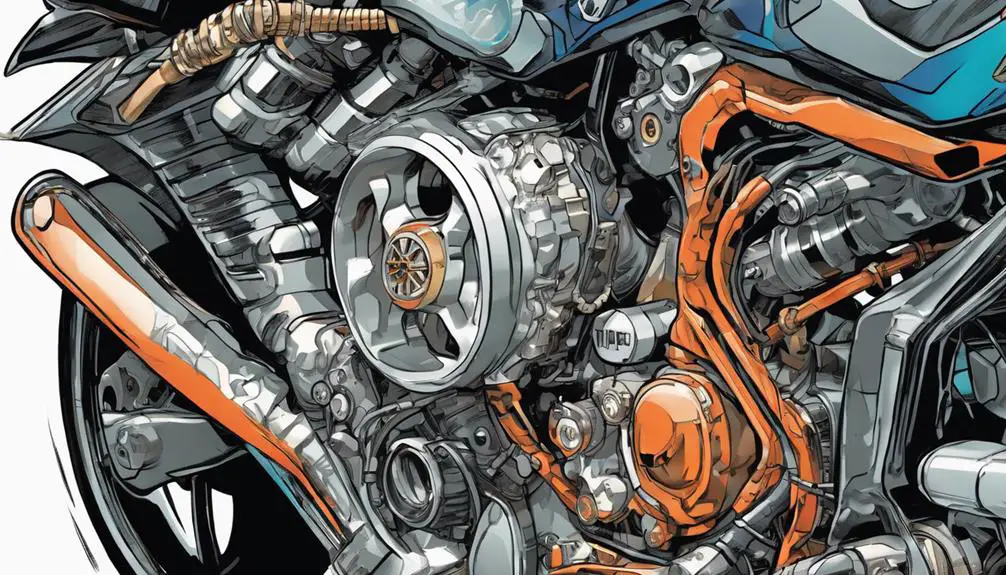
When it comes to sport bikes, engine displacement plays an essential role in determining performance.
You'll want to understand how power output and torque characteristics affect your ride.
Let's explore these metrics to see what they mean for your biking experience.
Engine Displacement Overview
Engine displacement plays an essential role in determining a sport bike's overall performance and power output. It refers to the total volume of all the cylinders in the engine, and it directly impacts how much air and fuel the engine can draw in, ultimately influencing your riding experience.
Here's what you should know about engine displacement:
- Torque and Throttle Response: Larger displacements generally provide more torque, allowing for quicker acceleration and a more responsive throttle.
- Weight-to-Power Ratio: A well-balanced displacement can enhance your bike's agility, making it feel lighter and more nimble on the road or track.
- Rev Limit: Displacement affects the engine's ability to rev high; some riders prefer smaller engines that can spin faster for a thrilling ride.
- Fuel Efficiency: While larger engines may offer more power, smaller displacements can yield better fuel economy, giving you more freedom to explore without constantly stopping for gas.
Understanding these elements allows you to choose a sport bike that aligns with your desire for liberation on two wheels.
Embrace the journey ahead!
Power Output Analysis
Power output is vital for maximizing your sport bike's performance, as it directly correlates with engine displacement and greatly influences your overall riding experience.
Fundamentally, the larger the engine displacement, the more air and fuel it can combust, leading to higher power output. This power allows you to experience exhilarating acceleration, enabling you to embrace the freedom of the open road.
When you analyze the power output of a sport bike, you'll often see figures measured in horsepower or kilowatts. These metrics are essential for understanding how your bike will perform in various conditions, from city streets to winding mountain roads. A higher power output means quicker responses and thrilling rides, especially during high-speed maneuvers.
However, it's not just about raw numbers; the way that power is delivered matters too. A smooth, linear power band can make your ride more enjoyable and predictable, allowing you to feel truly connected to your machine.
Torque Characteristics Explained
Understanding torque characteristics is just as important as grasping power output, as torque plays a key role in your sport bike's acceleration and overall performance. Torque is the force that gets your bike moving, and knowing how it works can help you release your ride's full potential.
Here are four key aspects of torque to evaluate:
- Peak Torque: This is the maximum torque the engine can produce, often occurring at specific RPMs. It's vital for quick acceleration.
- Torque Curve: This graph shows how torque varies across the RPM range. A flatter curve means more consistent power delivery, making your ride more predictable.
- Low-End Torque: This refers to torque produced at lower RPMs, essential for smooth take-offs and city riding.
- High-End Torque: Torque available at higher RPMs contributes to thrilling top-end performance, ensuring your bike stays alive at high speeds.
Understanding these torque elements empowers you to make informed decisions, enhancing your riding experience.
Power Output and Torque Ratings
When evaluating sport bikes, you'll find that power output and torque ratings play an essential role in determining overall performance. These figures aren't just numbers; they reflect the bike's ability to deliver thrills and exhilaration.
Power output, measured in horsepower, indicates how much energy the engine can produce, while torque ratings reveal how effectively that power translates into acceleration.
You want a bike that can catapult you forward, offering that rush of freedom as you twist the throttle. Higher horsepower means faster top speeds, but don't overlook torque. It's critical for quick acceleration, especially when you're carving through curves or launching off the line.
Most sport bikes aim for a balance of both, providing that liberating feeling as you lean into turns and feel the engine roar. When you understand these specs, you're better equipped to choose a bike that aligns with your riding style.
Cooling Systems in Ducati Bikes
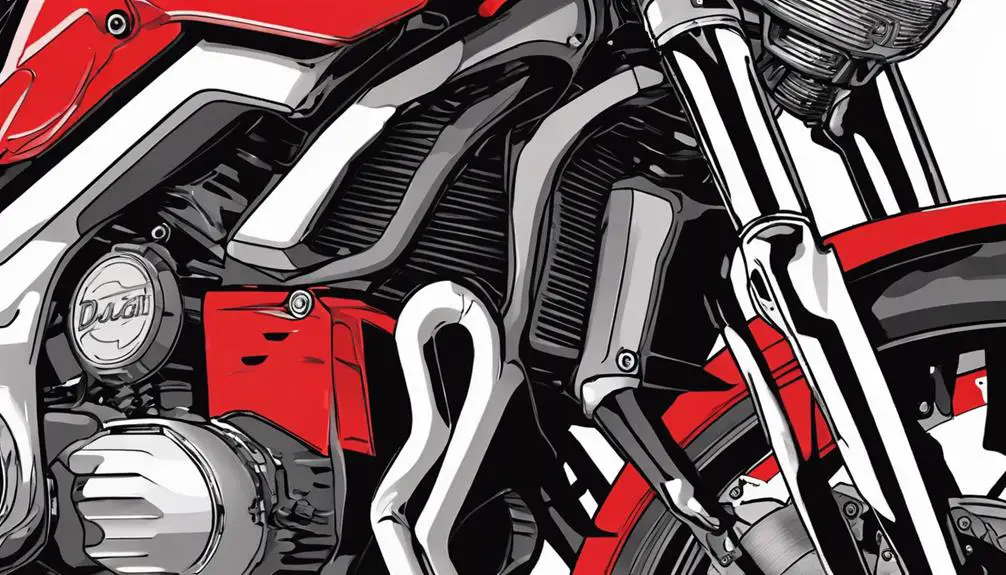
Ducati bikes are engineered with advanced cooling systems that guarantee peak performance, especially under the intense demands of high power output and torque. You'll appreciate how these systems keep your ride stable, allowing you to push boundaries without fear of overheating.
Here are four key features of Ducati's cooling systems:
- Liquid Cooling: A liquid-cooled engine efficiently dissipates heat, maintaining ideal operating temperatures for consistent performance.
- Radiator Design: Ducati employs high-capacity radiators that maximize airflow, ensuring that your bike stays cool even in heavy traffic or during long rides.
- Thermostatic Control: The integrated thermostat regulates coolant flow, providing precise temperature control and enhancing engine efficiency.
- Heat Shields: Strategically placed heat shields protect critical components, preventing heat from affecting performance and longevity.
With these systems in place, you can release your spirit of freedom without worrying about engine stress.
Ducati's commitment to cooling innovation keeps you in the fast lane, allowing you to experience the thrill of the ride fully. So gear up, hit the road, and feel the liberation that comes from riding a well-cooled, high-performance machine.
Transmission Specifications Explained
The transmission in sport bikes plays a crucial role in delivering power efficiently to the wheels, ensuring smooth acceleration and ideal performance on any ride. Most sport bikes use a six-speed sequential transmission, allowing you to shift gears quickly and precisely as you release the bike's full potential. This setup not only optimizes the engine's power band but also enhances your control over the bike, making every twist of the throttle exhilarating.
You'll find that some models incorporate a slipper clutch, which helps prevent rear wheel lock-up during aggressive downshifting, giving you the freedom to push your limits without fear. Quick-shifter technology is also gaining popularity, allowing you to shift gears without using the clutch. This feature gives you the ultimate freedom, enabling seamless changes between gears while keeping your focus on the road ahead.
The gear ratios in sport bikes are typically designed for high performance, providing excellent torque and acceleration. As you explore the open road, you'll appreciate how these transmission specifications work together to create a thrilling ride, giving you the confidence to conquer any challenge that comes your way.
Embrace the rush and let your spirit soar!
Fuel System Features
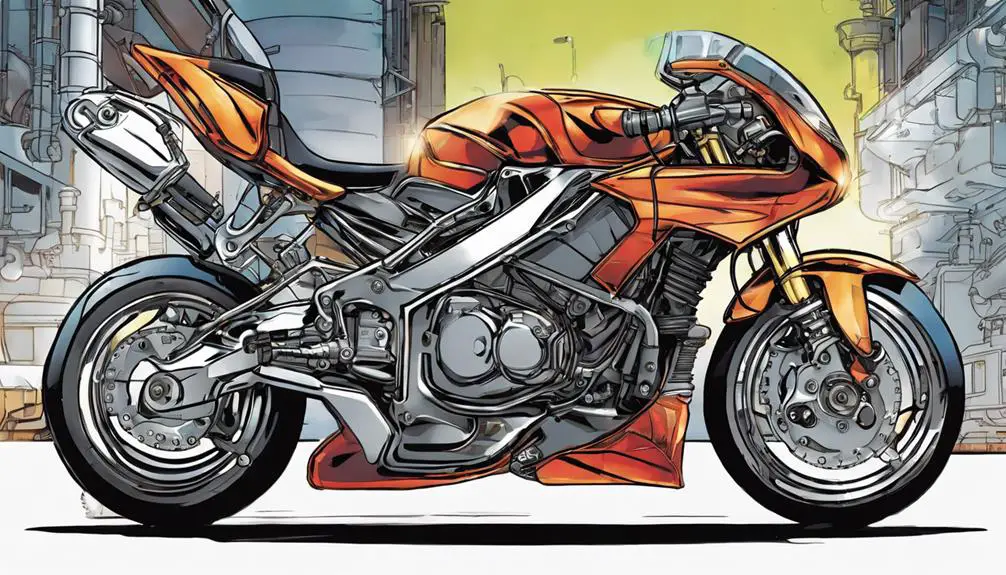
How does the fuel system in sport bikes enhance performance and efficiency on the road?
The fuel system plays an essential role in delivering the right amount of fuel to the engine, guaranteeing you release your bike's full potential. It's about precision and power, giving you the freedom to ride with confidence and exhilaration.
Here are some key features that elevate your experience:
- Fuel Injection: Modern sport bikes use electronic fuel injection (EFI) to optimize air-fuel mixtures, resulting in smoother acceleration and better throttle response.
- High-Pressure Fuel Pumps: These pumps guarantee a consistent supply of fuel, allowing for maximum performance even under extreme conditions.
- Advanced Fuel Mapping: Engineers design fuel maps tailored to specific riding styles, enhancing efficiency and power delivery for a more liberated ride.
- Lightweight Components: Sport bike fuel systems utilize lighter materials, reducing overall weight and improving handling and agility.
With these features, your sport bike becomes a finely-tuned machine, ready to respond to your every command.
Embrace the thrill of the open road, knowing your fuel system is working to keep you free and powerful.
Ignition and Starting Systems
Effective ignition and starting systems are essential for ensuring your sport bike fires up instantly and runs smoothly, delivering that thrilling ride you crave.
When you twist the throttle, you want that immediate response, and a reliable ignition system makes that happen. Most sport bikes utilize a digital ignition system that optimizes spark timing for maximum power and efficiency.
You'll also find that many models feature a lightweight starter motor, which reduces weight and improves performance. Electric starters are common, providing the convenience of a quick start without the hassle of kickstarting. Some bikes even come with advanced keyless ignition systems, allowing you to start your engine with the push of a button.
For those who love freedom, the thrill of the open road is enhanced by knowing your ignition system is efficient and dependable. Regular maintenance, like checking spark plugs and battery health, is vital to keep your bike ready to ride.
Emission Standards Compliance
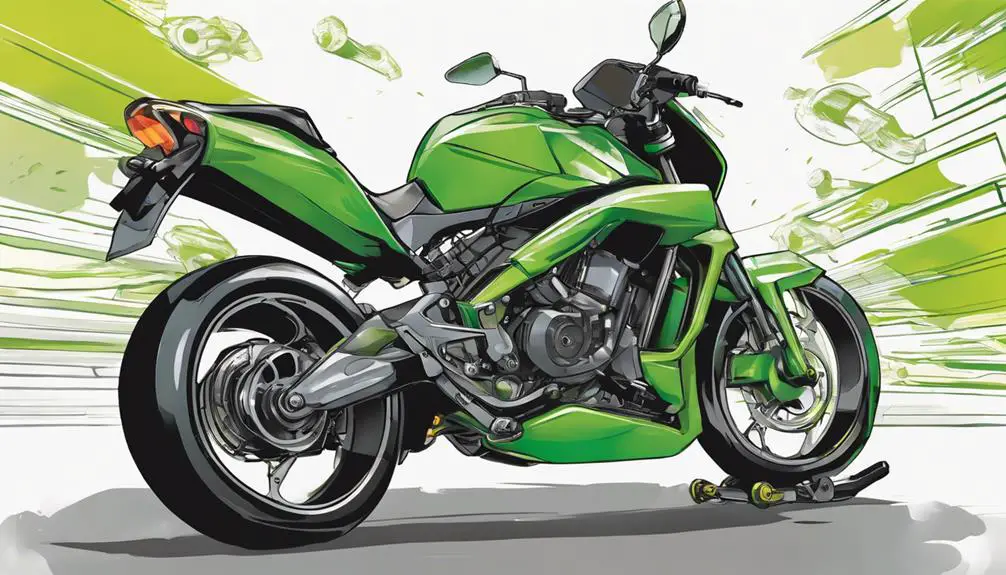
When it comes to sport bike engines, understanding emission standards compliance is essential.
You'll want to know the regulatory requirements and how they impact your bike's performance and environmental footprint.
Let's break down the testing procedures and considerations that keep your ride in line with the latest standards.
Regulatory Requirements Overview
Understanding emission standards compliance is essential for manufacturers aiming to meet regulatory requirements for sport bike engines. These standards aren't just bureaucratic hurdles; they play a crucial role in ensuring a cleaner environment while allowing you to enjoy the freedom of the open road.
Here are four key aspects you should consider:
- Regulatory Bodies: Familiarize yourself with the agencies responsible for setting emission standards, such as the EPA in the U.S. and the EU's regulations in Europe.
- Emission Limits: Know the specific limits for pollutants like hydrocarbons (HC), carbon monoxide (CO), and nitrogen oxides (NOx). Staying within these limits means you can ride without guilt.
- Technology Innovations: Embrace advancements like catalytic converters and fuel injection systems that help you meet these standards while enhancing performance.
- Market Trends: Keep an eye on evolving regulations. Adapting early can give you a competitive edge, ensuring your sport bike stays relevant in a changing landscape.
Emission Testing Procedures
Emission testing procedures are essential for ensuring that sport bike engines comply with established environmental standards. These tests measure the levels of pollutants emitted during operation, helping you know if your bike's engine aligns with regulations. By conducting these tests, you're not just fulfilling legal obligations; you're also contributing to a cleaner ride and a healthier planet.
When you take your bike for testing, it typically involves running the engine at various speeds and loads. This process assesses emissions like carbon monoxide, hydrocarbons, and nitrogen oxides. If your sport bike passes, you get a certificate proving compliance, allowing you the freedom to hit the road without worry. If it fails, don't despair. You can modify or tune your engine to meet the standards, enhancing both performance and environmental responsibility.
Stay informed about the specific emission standards in your area, as they can vary. Regular testing and maintenance keep your bike in peak condition and compliant. Embrace the liberation that comes with knowing you're riding responsibly and sustainably. With each ride, you're not just enjoying the thrill; you're also making a choice for a better future.
Environmental Impact Considerations
Compliance with emission standards is essential for reducing the environmental impact of sport bike engines. As a rider who craves freedom on the open road, you'll want to guarantee your passion doesn't come at the expense of the planet.
Here's how you can embrace eco-friendly riding:
- Choose Fuel-Efficient Models: Opt for sport bikes designed with advanced fuel injection systems that enhance combustion efficiency.
- Regular Maintenance: Keep your bike in top shape with frequent tune-ups to guarantee it runs clean and emits fewer pollutants.
- Utilize Eco-Friendly Fuels: Explore options like ethanol-blended fuels or alternative energy sources that reduce your carbon footprint.
- Stay Informed: Keep up with changes in emission standards and choose bikes that not only meet but exceed those requirements.
Common Engine Issues and Solutions
Sport bike engines can face a variety of common issues, but knowing how to identify and resolve them can keep your ride smooth and reliable.
One frequent problem is overheating. If your bike's temperature gauge climbs too high, check your coolant level and verify the radiator isn't blocked. A quick flush can often solve this.
Another issue is poor fuel performance, which might leave you feeling sluggish. This could stem from clogged fuel injectors or a dirty air filter. Cleaning or replacing these components can restore that exhilarating acceleration you crave.
You might also notice strange noises, such as knocking or tapping sounds. These often indicate low oil levels or worn engine components. Regularly checking your oil and changing it per the manufacturer's recommendations can prevent serious damage.
Lastly, if you experience electrical issues, like flickering lights or a dead battery, inspect your connections and terminals for corrosion. A clean, tight connection can often revive your bike's electrical system.
Frequently Asked Questions
How Do Ducati Engines Compare to Competitors in Performance?
When you compare Ducati engines to competitors, you'll notice they excel in performance, thanks to their powerful L-twin configurations. They deliver impressive torque and acceleration, making rides exhilarating.
While other brands may focus on higher RPMs, Ducati balances power and handling, giving you confidence in every turn.
You'll appreciate the distinctive sound and engineering, which often sets Ducati apart, creating a unique riding experience that resonates with those seeking freedom on two wheels.
What Maintenance Is Required for Ducati Sport Bike Engines?
To keep your Ducati's engine purring perfectly, you'll need to perform periodic practices.
Prioritize oil changes, check the chain tension, and inspect the air filter.
Don't forget to replace spark plugs and monitor coolant levels.
Regularly reviewing these routines guarantees smooth sailing on your speedy rides.
Embrace the exhilarating freedom of the open road by keeping your bike in top shape, allowing you to release its power without worry.
Are There Aftermarket Modifications for Ducati Engine Performance?
Yes, there are plenty of aftermarket modifications you can explore to boost your Ducati's engine performance.
You can upgrade the exhaust system for better airflow, install a high-performance air filter, or remap the ECU for optimized fuel delivery.
You might also consider lightweight components to enhance agility.
Each modification can release your bike's potential, giving you that exhilarating ride you crave.
How Does Engine Design Affect Handling and Stability?
Engine design plays an essential role in handling and stability.
When you optimize weight distribution and center of gravity, you enhance your bike's responsiveness. A well-designed engine can lower the overall weight, improving maneuverability.
Additionally, engine placement affects how you perceive handling; a lower engine can keep the bike grounded at high speeds.
If you seek liberation in your ride, understanding these design principles helps you choose a bike that responds intuitively to your commands.
What Is the Typical Lifespan of a Ducati Sport Bike Engine?
When you think about a Ducati sport bike engine's lifespan, imagine the thrill of speed versus the reality of maintenance.
Typically, you can expect around 40,000 to 60,000 miles if you take good care of it. However, with proper tuning and regular service, you might push that number even higher.
Just remember, the freedom of the open road requires commitment, so keep your engine healthy, and it'll reward you with exhilarating rides.
Conclusion
In the world of sport bikes, engine specifications are the heart that revs the excitement.
Ducati's innovative designs, from L-Twin engines to advanced cooling systems, guarantee you get thrilling performance while meeting emission standards.
Understanding these specs isn't just for gearheads; it's for anyone craving the adrenaline rush of the open road.
As you gear up for your next ride, remember: the engine's roar is music to a rider's soul, blending power and passion in perfect harmony.